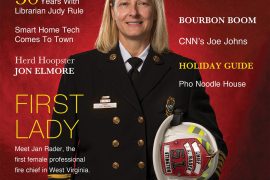By Jack Houvouras
HQ 126 | Summer 2024
If you’ve ever told a stranger that you’re from West Virginia, then you have no doubt heard the following response: “Is that near Richmond?” Whenever I’m confronted with that query, I always smile politely and say, “Not really.” What I’d like to say is, “Actually, West Virginia is a separate state from the Commonwealth of Virginia. It has been that way since the Civil War.”
It’s troubling to learn that more than 160 years since West Virginia was founded, there are still scores of Americans who have no idea it’s a state. And for those who are aware of that fact, their perceptions of the Mountain State are most unfavorable.
I first encountered some of those negative stereotypes when I went to Florida for my freshman year in college. There I met students from nearly every state in America. Because I was from West Virginia, almost all of them assumed either that I lived on a farm with pigs and cattle or that my father was a coal miner. Over the years I’ve heard people associate the Mountain State with television’s Beverly Hillbillies, the movie Deliverance and impoverished rednecks. I’m quick to inform them that the Clampetts were from the Ozark Mountains in Arkansas and Deliverance was set in Georgia. I then proceed to tell them that while folks like Larry the Cable Guy are not from West Virginia, these individuals are — Pearl S. Buck, Chuck Yeager, Jerry West, John Nash, Katherine Johnson, Mary Lou Retton, Randy Moss, Nick Saban and Jennifer Garner.
All of this proves that West Virginia has an identity problem. As if that weren’t enough to contend with, there is the question of West Virginia’s cardinal point in America. Is the state located in the North, South or Midwest? The answer is ambiguous at best.
From a geographical standpoint it can be argued that most of the state falls beneath the Mason-Dixon Line, and therefore is in the South. In addition, from 1788-1863 the state was part of Virginia which is obviously in the South. Visitors to West Virginia often describe the citizens as warm and welcoming, two distinctly Southern traits.
But that reasoning belies the fact that West Virginia seceded from Virginia at the onset of the Civil War and aligned itself with the North. It officially joined the Union in 1863 and became the only modern state to declare its independence from the Confederacy. As such, today it can never be considered as part of the South.
Finally, West Virginia is not part of the Midwest. While many of its core industries were Rust Belt in nature for decades, it simply doesn’t fit into that geographic region.
So where does that leave us? As the only state entirely within the Appalachian Mountain range, it could easily be called “Appalachian.” Or, because a defining characteristic of West Virginians is that they are fiercely independent, perhaps the state should stand alone, free of any territorial label.
As for me, whenever I’m asked if my home state should be considered North, South or Midwest, I simply say, “I tend to agree with John Denver. I think West Virginia is pretty close to heaven.”





